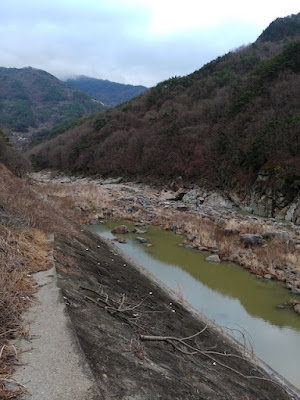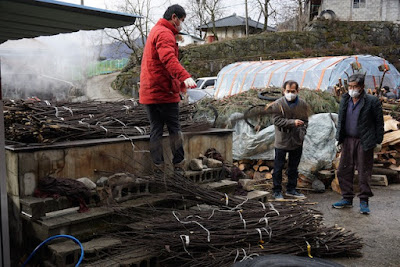There is always good luck when I make these trips. On my first big grant to Korea, I was able to go almost right away to Shin Hyun-se Traditional Hanji, and he remains the best papermaker in the country when it comes to conservation-grade hanji. This time, almost right away I was able to travel with Dr. Jo to see Dr. Lee's project at Lee Sang-ok Traditional Hanji in Hamyang, near Jirisan (not to be confused with the now defunct Jirisan Hanji).
Originally I was going to miss the steaming of dak bark, but then I was at lunch with Dr. Lee in Seoul (again, he just happened to be there for work when I was there and we met in the days after my release from quarantine) and he took a phone call that delayed the big steam. A flurry of calls later, we also realized that the weekend and the March 1 independence movement holiday would force the process to be delayed with just enough time for me to finish up my first Jeonju trip and head to Jinju on the holiday. Very early the next morning, Dr. Jo picked me up, drove to the dawn market to get a box of frozen fish as a gift for the papermaking family, and we drove into the mountains. This is where Lee Sang-ok used to do the dak steaming, but has since moved the steaming location.
Dr. Jo said that this is the process that every photographer wants to shoot, of steam rising from the bundled dak shoots. The family must have been up very early to be able to get the fire started and the trees sufficiently steamed for stripping.
At left is Mr. Lee's younger son Lee Kwon-hee, and at right is his wife, Yoon Gong-im. This is the first time I have ever stopped to ask the supporting cast for their names. Korea's hierarchical culture and society means that names are very rarely used. Everyone is called by their relation to someone else, so I would call people "son" or "wife" or "Mrs." or "so-and-so's mom" and so on. It's only now that I even felt I could ask for names, as it feels like such an intimate ask. Unthinkable in American culture, but I seriously don't know the names of my own close family members (mostly the women, as the man's name is the most important).
Here, she is testing to see if the bark strips easily away to make sure the steaming has been successful, and it has. BTW, women in Korea do not change their names when they get married, which is why her surname differs from her husband's.
The outer bark has pulled away from the inner woody core.
They've fed water to the pile already and he is now tossing bundles to the ground to start stripping. Dr. Jo is in the middle, and Lee Sang-ok is at right. He is not in great health so his wife kept yelling at him not to work.
You can see different colors, and that's because the whole point of Dr. Lee's project is to test the amount of white bark that comes from trees in 45 different regions of the entire country. The challenge this year is that last summer was a horrible monsoon season: ENDLESS rain, too much water for the trees. Every papermaker last winter complained about how poorly the trees grew from excess water. How any of this research gets done during such drastic climate change, I have no idea.
These are the three women who came to strip bark, and I'm guessing that Dr. Jo is exhorting them to do something or other. They need to keep all of the bundles in the same batch so that the Dr. Lee's research team can keep track of them.
Of course, only after my two visits to the mill did I realize that I never got the names of these women. They are always ajumma ('auntie') to me, and that's cultural. Whether it's an problem or not is for other people to decide, but it's really different from American culture. I also generally hate to bother people while they are working. Drs. Jo and Lee had already talked a lot prior to our visit about how when outsiders come to visit papermakers, they always get in the way, slow down work, and sometimes completely stop work.
But I'm glad that Minah Song has written an essay about the reality of papermaking that will appear in the second volume of Papermaker's Tears. We had a conversation sometime during pandemic about how she dislikes when people call papermaking "magic." I am guilty of that exactly, but her point is that papermaking is not magic, it's a shit ton of hard work. And so much of that work is invisible, and done by women. Whose names are not included in the record.
At least that's my understanding of parts of her essay. All I know is that it will be REALLY good and worth buying the entire volume for when it's eventually published (I have a follow-up essay in there about two more toolmakers). Minah is the most hardcore scholar/conservator/paper person I know, and she is insanely smart, experienced, and gifted—and equipped to do research that I cannot, as she can do serious research in the three major languages of East Asia.
We were able to take a peek at the workspace where they actually beat, pull, and dry hanji.
This is from a book about artisans in the Jirisan area (the tallest mountain in mainland South Korea) and you can see Mr. Lee forming webal sheets. I had no idea that his mill only makes hanji in this fashion (meaning no other sheet formation styles, like the Japanese techniques you see at many other mills in Korea). I thought it was only one other mill in Korea that did that, but I've learned quickly on this trip that I have learned a lot of incorrect info. Stuff that doesn't matter to most people, but is really important to get right so that hanji's history and current state are accurately reflected.
This was one of many revelations: burdock burrs picked after the flowers wilt, dried in the shade, used to clean the bamboo screens after making paper!! We do all kinds of things in the US like spray with water (this is a great way to destroy your screens, as the nozzles and hose pressure can be super strong) and rub with toothbrushes. But apparently this is the way to go. I will try to grow some when I get back home, and hope that the deer stay away.
These are drying brushes made of Miscanthus and also another plant....if not done properly, the grasses all bloom and turn into what looks like cotton candy. I was going to do this entire post at once but realized it's too much for this platform (and me) to handle. This first trip was on 2021 March 2 and I have been very upset not to be able to post about it sooner, but that is my life right now. I also have not yet transcribed any of my notes from that visit but hope to get that done in the coming week now that I am back in Jeonju for a bit and can stay in ONE place after a month and a half of nomadic life.

















No comments:
Post a Comment